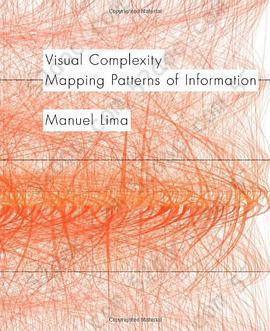注重体验与质量的电子书资源下载网站
分类于: 人工智能 计算机基础
简介

Visual Complexity: Mapping Patterns of Information 豆 8.7分
资源最后更新于 2020-10-05 18:42:44
作者:Manuel Lima
出版社:Princeton Architectural Press
出版日期:2011-01
ISBN:9781568989365
文件格式: pdf
标签: 可视化 visualization 数据可视化 设计 数据图表 data 交互设计 科普
简介· · · · · ·
Our ability to generate information now far exceeds our capacity to understand it. Finding patterns and making meaningful connections inside complex data networks has emerged as one of the biggest challenges of the twenty-first century. In recent years, designers, researchers, and scientists have begun employing an innovative mix of colors, symbols, graphics, algorithms, and in...
目录
The book is divided in seven chapters and I like to think of it almost as a symphony, with the first three chapters providing a foundational opening for the lavish visual burst of chapters 4 and 5 - the sonata’s allegro or vivace - immediately followed by its final cadence, “Complex Beauty” (perhaps my favorite chapter) and “Looking Ahead”. Here’s a bit on the book’s structure, as explained in the Introduction:
01 | The Tree of Life
The book opens with “Tree of Life,” an exploration of the sacred meaning of trees and their widespread use as a classification system over the centuries. It showcases an assortment of ancient representations — as predecessors of modern-day network diagrams — where the tree metaphor is used to visually convey a variety of topics, from theological events to an encyclopedia’s table of contents.
02 | Form Trees to Networks
The second chapter, “From Trees to Networks,” makes the case for a new network-based outlook on the world, one that is based on diversity, decentralization, and nonlinearity. It explores several instances — from the way we envision our cities to the way we organize information and decode our brain — where an alternative network model is replacing the hierarchical tree schema.
03 | Decoding Networks
Chapter three, “Decoding Networks,” delves into the science behind network thinking and network drawing, providing a short introduction to its main precursors and early milestones. It also takes a pragmatic and utilitarian look at network visualization, acknowledging its key functions and proposing a set of guiding principles aimed at improving existing methods and techniques.
04 | Infinite Interconnectedness
Following a series of functional recommendations for network visualization, chapter four, “Infinite Interconnectedness,” presents a large number of examples divided into fourteen popular subjects. From depictions of the blogosphere to representations of terrorist networks, chapter four highlights the truly complex connectedness of modern times.
05 | The Syntax of a New Language
If chapter four looks at the practice primarily through its most common themes, chapter five, “The Syntax of a New Language,” organizes a vast array of projects by their shared visual layouts and configurations. As designers, scientists, and researchers across the globe portray an increasing number of network structures in innovative ways, their collective effort forms the building blocks of a new network-visualization lexicon.
06 | Complex Beauty
After presenting an abundance of network-visualization examples in chapters four and five, chapter six, “Complex Beauty,” examines the alluring nature of networks, responsible for a considerable shift in our culture and society. Alternating between scientific and artistic viewpoints, this chapter explores the divide between order and complexity before culminating in a discussion of an original art movement embracing the newly discovered beauty of the network scheme.
07 | Looking Ahead
Finally, and in the spirit of network diversity and decentralization, “Looking Ahead,” the last chapter, presents different views on the influential growth of visualization, according to renowned experts, active participants, and attentive observers. The featured essays cover an array of trends and technologies shaping the progress of visualization and provide an immensely captivating perspective on what may lie ahead.
01 | The Tree of Life
The book opens with “Tree of Life,” an exploration of the sacred meaning of trees and their widespread use as a classification system over the centuries. It showcases an assortment of ancient representations — as predecessors of modern-day network diagrams — where the tree metaphor is used to visually convey a variety of topics, from theological events to an encyclopedia’s table of contents.
02 | Form Trees to Networks
The second chapter, “From Trees to Networks,” makes the case for a new network-based outlook on the world, one that is based on diversity, decentralization, and nonlinearity. It explores several instances — from the way we envision our cities to the way we organize information and decode our brain — where an alternative network model is replacing the hierarchical tree schema.
03 | Decoding Networks
Chapter three, “Decoding Networks,” delves into the science behind network thinking and network drawing, providing a short introduction to its main precursors and early milestones. It also takes a pragmatic and utilitarian look at network visualization, acknowledging its key functions and proposing a set of guiding principles aimed at improving existing methods and techniques.
04 | Infinite Interconnectedness
Following a series of functional recommendations for network visualization, chapter four, “Infinite Interconnectedness,” presents a large number of examples divided into fourteen popular subjects. From depictions of the blogosphere to representations of terrorist networks, chapter four highlights the truly complex connectedness of modern times.
05 | The Syntax of a New Language
If chapter four looks at the practice primarily through its most common themes, chapter five, “The Syntax of a New Language,” organizes a vast array of projects by their shared visual layouts and configurations. As designers, scientists, and researchers across the globe portray an increasing number of network structures in innovative ways, their collective effort forms the building blocks of a new network-visualization lexicon.
06 | Complex Beauty
After presenting an abundance of network-visualization examples in chapters four and five, chapter six, “Complex Beauty,” examines the alluring nature of networks, responsible for a considerable shift in our culture and society. Alternating between scientific and artistic viewpoints, this chapter explores the divide between order and complexity before culminating in a discussion of an original art movement embracing the newly discovered beauty of the network scheme.
07 | Looking Ahead
Finally, and in the spirit of network diversity and decentralization, “Looking Ahead,” the last chapter, presents different views on the influential growth of visualization, according to renowned experts, active participants, and attentive observers. The featured essays cover an array of trends and technologies shaping the progress of visualization and provide an immensely captivating perspective on what may lie ahead.








